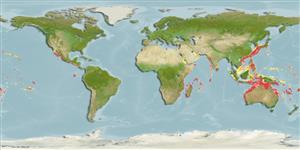Classification / Names
Common names from other countries
Main reference
Size / Weight / Age
Max length : 428 cm TL male/unsexed; (Ref. 106604); 383.0 cm TL (female); common length : 276 cm TL male/unsexed; (Ref. ); max. reported age: 29 years (Ref. 48844)
Length at first maturity
Lm ?, range 260 - 292 cm
Environment
Marine; pelagic-oceanic; oceanodromous (Ref. 51243); depth range 0 - 300 m (Ref. 106604), usually 0 - 150 m (Ref. 55167)
Climate / Range
Tropical, preferred ?; 40°N - 32°S, 34°E - 83°W (Ref. 54277)
Distribution
Circumglobal. Indo-Pacific: Red Sea, Arabian Sea, Maldives (Ref. 30829), Somalia, South Africa, Western Australia, China, Taiwan, Japan, New Caledonia, Hawaiian Islands and Tahiti. Eastern Pacific: Gulf of California and the Galapagos. Reliable records lacking partly due to its confusion with Alopias vulpinus.
Countries | FAO areas | Ecosystems | Occurrences | Introductions
Short description
Dorsal
spines
(total): 0;
Dorsal
soft rays
(total): 0;
Anal
spines: 0;
Anal
soft rays: 0. A small thresher with moderately large eyes, a broadly convex forehead, a very narrow caudal tip, and straight, broad-tipped pectoral fins (Ref. 5578). Upper lobe of caudal fin very long and strap-like, almost equal to length of rest of shark; lower lobe short but strong; terminal lobe very small (Ref. 13570). Dark blue on back and sides, underside white; no white patch over pectoral fin bases (Ref. 5578).
IUCN Red List Status (Ref. 115185)
Human uses
Fisheries: commercial; gamefish: yes
More information
ReferencesAquacultureAquaculture profileStrainsGeneticsAllele frequenciesHeritabilityDiseasesProcessingMass conversion
Tools
Special reports
Download XML
Internet sources
Estimates of some properties based on models
Phylogenetic diversity index
PD50 = 0.7500 many relatives (e.g. carps) 0.5 - 2.0 few relatives (e.g. lungfishes)
Trophic Level
4.5 ±0.66 se; Based on food items.
Resilience
Very Low, minimum population doubling time more than 14 years (Fec=2; tm=7-9; tmax = 29)
Vulnerability
Very high vulnerability (86 of 100)
Price category
